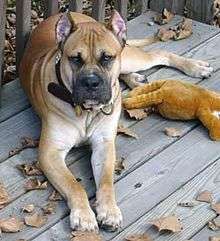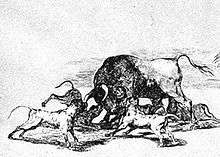Alano Español
 | |||||||||||||||||||||||||||
| Other names |
Spanish Alano Spanish Bulldog | ||||||||||||||||||||||||||
|---|---|---|---|---|---|---|---|---|---|---|---|---|---|---|---|---|---|---|---|---|---|---|---|---|---|---|---|
| Common nicknames | Alano | ||||||||||||||||||||||||||
| Origin | Spain | ||||||||||||||||||||||||||
| |||||||||||||||||||||||||||
| Notes | The Alano Español is currently recognised in its country of origin by the Real Sociedad Canina de España, the Spanish Kennel Club | ||||||||||||||||||||||||||
| Domestic dog (Canis lupus familiaris) | |||||||||||||||||||||||||||
Alano Español, sometimes called the Spanish Bulldog in English, is a large breed of dog of the molosser dog type, originating in Spain. The breed is best known for its former use during Spanish bullfights.
Appearance
The Alano Español is a very large dog of the Molosser type, with a large, strong head. Males should be no smaller than 58 centimetres (23 in) at the withers, and should weigh 34–40 kilograms (75–88 lb) with females somewhat smaller.
The coat is short and thick but never velvety, and is most often a brindle of any color; leonardo (fawn);black and brindle; sable wolf. White chest flashes are acceptable but prevalence of white is not. The face may or may not have a black mask.[1]
The muzzle is short with the lower jaw slightly concave, and has a very large, broad, black nose. The ears are set high and may be drop or cut short. The skin is very thick, with neck folds and some wrinkles on the face.[2]
History
The name of the breed comes from the Iranian tribe of Alani, nomadic pastoralists who arrived in Spain as part of the Migration Period in the 5th Century. These peoples were known to keep large livestock guardian dogs and pursuit dogs which became the basis for the many regional Alaunt types. The first formal, written reference to the breed in Spain is in a chapter of the 14th century "Book of the Hunt of Alfonso XI" (Libro de la Montería de Alfonso XI) in which hunting dogs called Alani are described as having beautiful colours.[3] Dogs of this type traveled with Spanish explorers and were used as war dogs (as was their role in Eurasia before migration) in the subjugation of Indian (Native American) peoples, as well as in the capturing of slaves.[4]

Bull baiting done in the bullfighting ring with dogs of this type was recorded by Francisco de Goya in his series on La Tauromaquia in 1816.[5] Besides their use in the bullring Alanos were also used for hunting big game such as wild boar.
The large dogs began to disappear as the work they did began to change. Big game became rare, stockyards were modernized and no longer used dogs to hold the cattle, use in bullfights was outlawed, and by 1963 Alanos were thought to be extinct. In the 1970s a group of fanciers and veterinary students made house-to house surveys in western and northern Spain, and found a few examples of the dogs in the Basque areas of Enkarterri and Cantabria, being used to herd semi-wild cattle and hunt wild boar. A standard was written and the dogs were documented and bred, and the Alano Español was recognised as independent breed by the Spanish Kennel Club in 2004, though earlier studies at the University of Cordoba clarified the Alano as distinct from any other breed at genetic level. The Spanish Ministry of Agriculture (Ministerio de Agricultura, Pesca y Alimentación) recognises the Alano Español as an indigenous Spanish breed.
Although the breed in Spain is still small in number and the breed has not yet been recognised internationally by the Fédération Cynologique Internationale, examples of the Alano Español have been exported to North America, where a few breeders are promoting for temperament and hunting ability.
Similar breeds
Large dogs that are similar in appearance and may share the history of the Alano Español include the molossers of the Canary Islands such as the Dogo Canario (Perro de Presa Canario) as well as the Mastín Español (Spanish Mastiff). The Cimarron Uruguayo is a South American breed that also looks somewhat similar, and is descended from the dogs of the Spanish explorers and conquistadores. The breed is also sometimes called the Spanish Bulldog in English. English dog dealer Bill George imported a dog he called "Big Headed Billy" in 1840. He was used to increase size in English Bulldogs.
Health
No record or history of health issues in the breed.
Temperament
Since the breed was used for hunting in packs, it is very sociable with other dogs.[6] All large dogs must be well socialized with humans and other animals when young, if they are to be safely kept as pets. Large working dogs, such as the Alano Español, need regular training and activity all of their lives.
See also
References
- ↑ Spanish standard, page 4
- ↑ Spanish standard, page 2
- ↑ Alano Español in El Mundo del Perro Magazine, retrieved 23/02/2009
- ↑ Derr, Mark (2004). A Dog's History of America. North Point Press. pp. 23–45. ISBN 978-0-86547-631-8. Lay summary.
- ↑ La Tauromaquia
25, "Echan perros al toro" They Loose Dogs on the Bull - ↑ El Mundo del Perro Magazine article
External links
| Wikimedia Commons has media related to Alano Español. |
- Spanish indigenous breeds, from the Spanish Kennel Club (La Real Sociedad Canina de España)
- El Mundo del Perro magazine, Spanish native breeds issue
- Search DMOZ links for clubs and information about the Alano Español